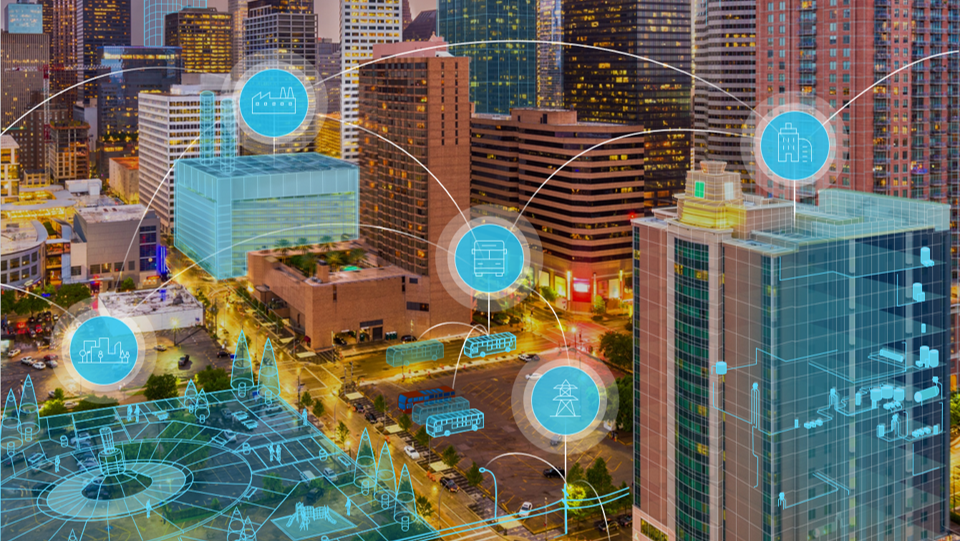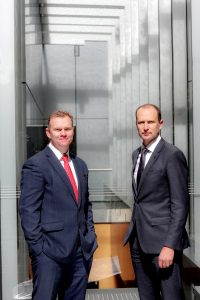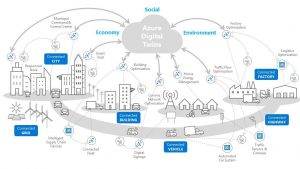
Digital twin transforms property sector with safer, smarter cloud solution
When the new office building Barrack Place at 151 Clarence Street in Sydney Australia opened its doors for the first time, the property owner and manager, Investa knew where each of the building’s 25,476 assets were located and their condition. That’s thanks to the creation of a digital twin of the building that will revolutionise the way the building is managed and tenants are served.
Heralded as the critical foundation for truly smart buildings and smarter cities, a digital twin is a precise virtual replica of a physical entity.
Digital twins are not only able to map out every floor, wall, stair, lift, doorhandle in a building, but instead extend far beyond an online blueprint. They also capture real time data from sensors about the health of assets, monitors the location of people in a building, and also acts as a repository of data about the building – holding everything from the original architect’s drawings through to the warranties and service histories associated with plant and equipment.
Managed in and accessed through the cloud ensures instant access to information to help optimise building management – and deliver critical real time insight should a building ever need to be evacuated or locked down.
Australian technology company Willow uses Microsoft’s Azure Digital Twins technology to create digital twins for the built environment. Its customers include international giant thyssenkrupp Elevator and Australian commercial property owner and manager, Investa.
Mark Tait, Group Executive and Head of Commercial Development at Investa, says digital twin technology is transforming the business by providing complete transparency about a building to the owners and occupiers. In practical day-to-day terms that means “Building management has a far better relationship with tenants because the real time live data sets allow them to respond far quicker.”
A maintenance request in the purely analogue world may have had a building manager scrambling through 50 lever-arch folders, looking for asset specifications or the associated warranty. With a digital twin that’s all available on a smartphone or tablet, allowing instant action.
In new builds, development of a digital twin in lockstep with the construction of the physical building means that at handover the owner operator has complete transparency about the building, compliance, and the assets to be managed, improving efficiency and reducing risk.
“It’s a significant step change” says Tait.
Massive impact
With his deep knowledge of the property industry, Willow CEO and co-founder, Joshua Ridley, has been exploring the concept of digital twins for several years and hone his understanding of the impact that transparency from the vast amounts of information created in the construction of buildings could have on the operational efficiency, sustainability and safety of the built environment as well as the tenant experience
Willow Twin powered by Microsoft Azure Digital Twins has allowed his concept to become reality.
“A digital twin is a fusing of the physical and the digital. It’s replicating in a digital form what we have in a building – the devices in the building, all the data in operations and maintenance manuals, and warranties,” says Ridley.
It also ingests data from sensors that provide real time updates about how spaces in and around the building are being used.
While the approach will revolutionise facilities management and the tenant experience, Ridley envisages even broader impact at a smart city level, for example by being able to share information about people movement with city infrastructure managers to optimise traffic and public transport flow.

Ridley and Tait have been working together toward their goal of creating digital twins for physical buildings for a couple of years. What has brought their plans to life says Ridley is a combination of processing power, speed and scale thanks to Microsoft Azure.
Cloud computing, ubiquitous internet and highly affordable Internet of Things sensors mean that there is now “A monumental opportunity with digital twins to combine the design and build phase,the operation of the building and tenant experience into one system,” says Ridley.
It is also possible to retrofit digital twin solutions onto older buildings, by breaking open data silos holding design and construction information, and using APIs integrating that information with data held in an operations and building management system.
Tait acknowledges that building and construction has taken its time to embrace digital transformation opportunities, tending to revert to business-as-usual. Now he said there is an opportunity to de-risk even the most major projects by overlaying technology that reduces waste, ensures quality and speeds completion.
The impact of such digital transformation can be profound says Tait. “Say you are a tenant with two floors in a building and you want to install some inter-tenancy stairs. Traditionally it could take a week or two weeks to do the planning – with the Willow platform they have access to that information in five minutes.
“With a new build like Investa’s flagship development at 60 Martin Place in Sydney, which is now a year from completion, when we started we had to access Council archives to find all the old drawings for the building.”
“Today we will have our building managers’ have all the data sets and manuals on a Surface Pro. It will be one of the most technologically advanced buildings in Australia in this space, if not the world.”
Microsoft’s Azure Digital Twins technology offers spatial intelligence graphing to model the relationships of people, places and devices, to gather insights that optimise space utilisation and occupants’ experience.
Pre-defined schema and protocols are available to accelerate development of digital twins, and it’s also possible to create alerts for building managers that can send notifications based on incoming telemetry messages to the digital twin allowing rapid response.
Azure Digital Twins also controls access to the information ensuring only authorised personnel with valid credentials can view and modify data.
Willow’s solution takes data feeds from elevators, security systems, cooling and lighting, and sensors that monitor a range of other factors including occupancy. It meshes the real time data with client data such as building blueprints, 3D modelling, operations and maintenance manuals, warranties and the like accessed via API and brought into Azure SQL Data Warehouse which then creates the virtual replica in the form of an Azure Digital Twins.
Safe and sure
A digital twin has also been developed by Willow to streamline facilities management at Investa’s 567 Collins St building in Melbourne.
Completed in 2015 the 55,000 square meter building has 27 storeys and houses around 3,000 people. As Ridley explains; “Without Willow they would have had spreadsheets, lots of paper in files and a USB stick handed over at the end of the construction phase with significant information not captured.”
The digital twin for 567 Collins maps more than 57,000 assets in the asset register and takes feeds from 14,000 live data points in the building. Facilities management can identify an individual asset with one search and click, keep full records of compliance checks on assets, and gain instant access to warranties and manuals.
Also, following the Grenfell Tower disaster in London, there is increased pressure on building owners and operators to ensure that the building products and cladding used in the construction are to code and safe. A digital twin would hold that data, delivering clarity to building owners and providing peace of mind that their buildings are fully compliant already, or giving them information about problem areas so they know exactly what remediation is required.
“This is transparency that you would not normally have,” says Tait.
Future potential
Willow sees the Azure Digital Twins as the foundational technology for the fourth industrial revolution and a transformational change for both building owners, tenants and broader Smart City initiatives.
For example, the granular insights about tenants, and their employees’ whereabouts, allows for improved local precinct planning and operation, potentially extending to the use of digital wallets by people working in that particular zone.
In an emergency, the digital twin provides critically important information to building managers and first responders to ensure rapid and complete evacuation or lock down.
In Smart City applications, data feeds from a building’s digital twin can feed into the management systems used to optimise traffic and transport along with external data sources, such as weather forecasts.
For the property industry there are additional benefits says Tait. “Instead of going into Councils with drawings to talk about building massing and overshadowing which can be the first step in a process that takes 12 -18 months – in a Smart City you could have a digital model of a whole area and we plug in the building attributes from the digital twin. Planning approvals are streamlined and fast tracked with a positive environmental impact.“















